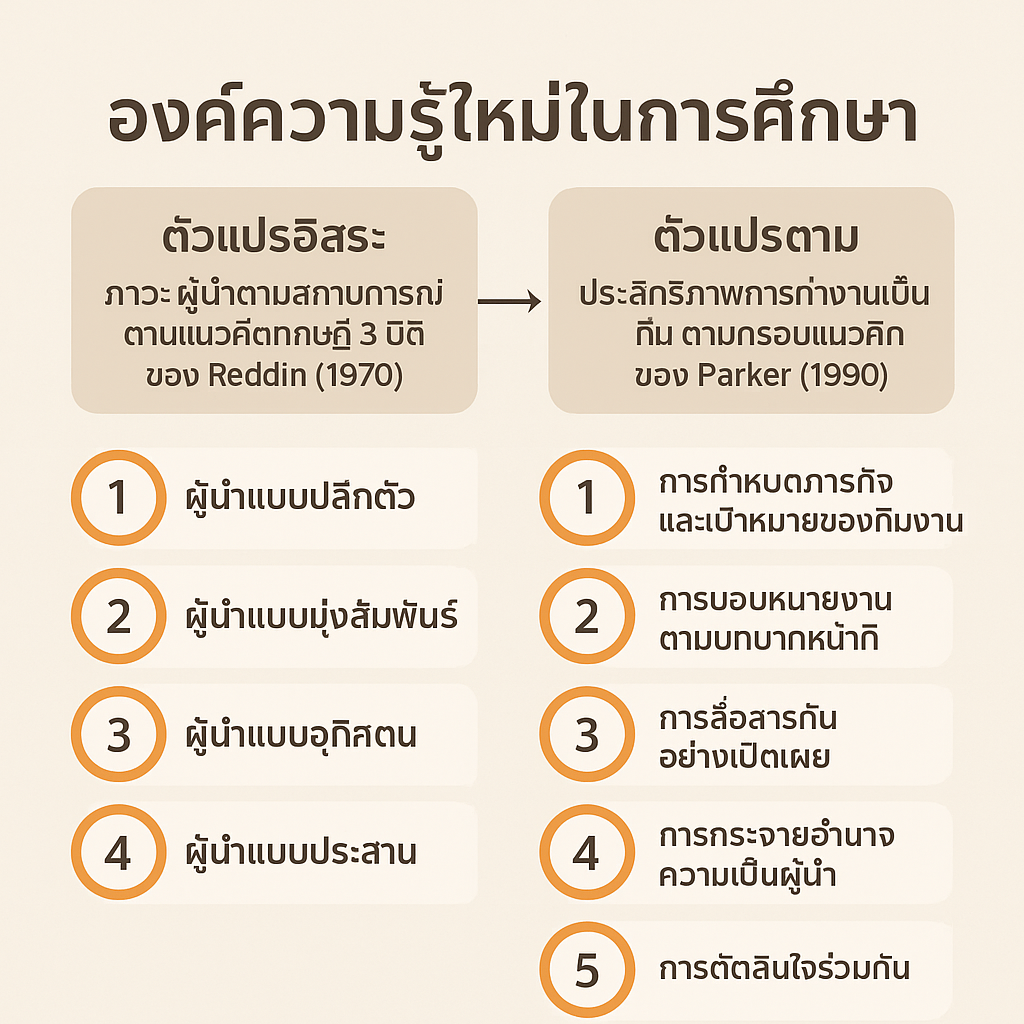Situational Leadership Affecting Teamwork Performance of Administrators and Teachers in Schools under the Nakhon Sawan Primary Educational Service Area 2
Keywords:
Situational leadership, teamwork, Area Education OfficeAbstract
The purposes of this research were First, to study level Situational Leadership of administrators and teachers in schools . Second, to study level teamwork efficiency of administrators and teachers in schools . Third, to study relationship between Situational Leadership effecting teamwork efficiency of administrators and teachers in schools. The sample group was administrators and teachers in schools . Chosen by simple random sampling 305 persons. The instrument for data collection was a set of five-rating scale questionnaire. The statistics of the analysis included quantity, frequency, percentage, mean, standard deviation, t-test, multivariate analysis of varianceand subsequent test by using Scheffe's method, Pearson’s product correlation coefficient and multiple regression analysis of correlation coefficient by using Stepwise’s method.
The results of this study were 1) the level of Situational Leadership of administrators and teachers in schools was at a high level 2) the level of teamwork efficiency of administrators and teachers in schools was at a high level 3) the relationship between Situational Leadership effecting teamwork efficiency of administrators and teachers in schools fuond that the positive correlation were statistically significant at the .01
References
กรมวิชาการ. (2544). การประกันคุณภาพภายในสถานศึกษาขั้นพื้นฐาน : แนวทางการบริหาร จัดการคุณภาพ สถานศึกษา. กรุงเทพมหานคร: สำนักทดสอบทางการศึกษา กรมวิชาการ กระทรวงศึกษาธิการ.
กรกนก บุญชูจรัส. (2552). ปัจจัยที่มีความสัมพันธ์ต่อการทำงานเป็นทีมของพัฒนาการใน พื้นที่ความรับผิดชอบของศูนย์ศึกษาและพัฒนาชุมชน จังหวัดเพชรบุรี. วิทยานิพนธ์ปริญญาศึกษาศาสตรมหาบัณฑิต. มหาวิทยาลัยศิลปากร.
ทิศนา แขมมณี.(2545). กลุ่มสัมพันธ์เพื่อการทำงานและการจัดการเรียนการสอน.กรุงเทพมหานคร: นิชินแอด เวอร์ ไทซิ่ง กรู๊ฟ.
เนตร์พัณณา ยาวิราช. (2549). ภาวะผู้นําและผู้นําเชิงกลยุทธ์. พิมพ์ครั้งที่5. กรุงเทพฯ: เซ็นทรัล เอ็กช์เพรส.
ปัทมา สายสอาด. (2551). ทักษะการติดต่อสื่อสารของผู้บริหารที่ส่งผลต่อประสิทธิภาพการทำงาน เป็นทีม ของครูในโรงเรียนสังกัดสำนักงานเขตพื้นที่การศึกษากาญจนบุรีเขต 2. วิทยานิพนธ์ปริญญา มหาบัณฑิต, บัณฑิตวิทยาลัย มหาวิทยาลัยศิลปากร.
ปาริชาต สมใจ. (2556). อิทธิพลของภาวะผู้นำตามสถานการณ์ของผู้บริหารสถานศึกษาต่อประสิทธิผลของสถานศึกษา สังกัดสำนักงานคณะกรรมการการศึกษาขั้นพื้นฐาน. วิทยานิพนธ์ปริญญาปรัชญาดุษฎีบัณฑิต สาขาวิชาการบริหารการศึกษา บัณฑิตวิทยาลัย มหาวิทยาลัยศิลปากร.
พิทักษ์ กานตอัมพร. การบริหารองค์กร. กรุงเทพฯ : โอเดียนสโตร์, 2549.
ไพโรจน์ บาลัน. ทักษะการบริหารทีม. กรุงเทพฯ : แอคทีฟพริ้นท์, 2551
วิโรจน์ สารรัตนะ. (2542). การบริหารหลักการทฤษฎีและประเด็นทางการศึกษา. กรุงเทพมหานคร: อักษราพิพัฒน์.
สุนันทา เลาหนันท์. (2551). การสร้างทีมงาน. พิมพ์ครั้งที่ 4. กรุงเทพฯ: แฮนด์เมดสติกเกอร์ แอนด์ดีไซน์.
สมบูรณ์ คันธโชติ. การสร้างทีมงาน. เอกสารประกอบการบรรยายหลักสูตรผู้บริหาร สถานศึกษาระดับสูง. กรุงเทพฯ : กองพัฒนาบุคคล
สำนักงานคณะกรรมการการประถมศึกษาแห่งชาติ, 2543. สํานักงานเขตพื้นที่การศึกษาประถมศึกษานครสวรรค์ เขต 2. ข้อมูลสารสนเทศสำนักงานเขตพื้นที่
Krejcie, R.V. and Morgan, D.W. (1970). Educational and Psychological Measurment. New York : Minnisota University.
Parker, G.M. (1990). Teamplayers and Team work: The New Competitive Business Strategy. San Francisco, Calif: Jossey-Bass.
Austin, A. E., & Baldwin, R. G. (1991). Faculty collaboration: Enhancing the quality of
scholarship and teaching. Washington, DC: The George Washington University,
School of Education and Human Development.
William, J. Reddin. (1970). Managerial Effectiveness. New York : McGraw-Hill Book Co.

Downloads
Published
How to Cite
Issue
Section
License
Copyright (c) 2025 Vol. 1, No. 2 (May-August) 2025

This work is licensed under a Creative Commons Attribution-NonCommercial-NoDerivatives 4.0 International License.
This article is published under a Creative Commons Attribution-NonCommercial-NoDerivatives 4.0 International License (CC BY-NC-ND 4.0), which allows others to share the article with proper attribution to the authors and prohibits commercial use or modification. For any other reuse or republication, permission from the journal and the authors is required.
